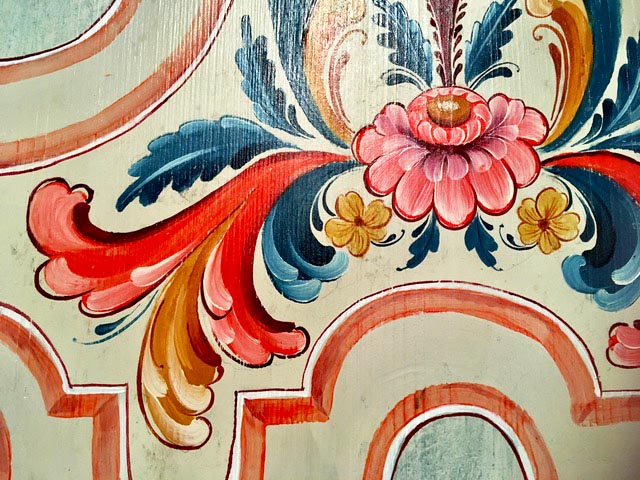
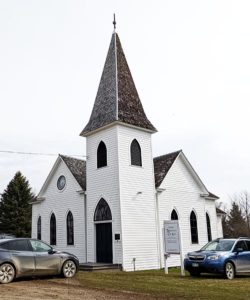
Historic Trondhjem Church in Lonsdale, Minnesota Emily Sajdak
In mid-July 2021, over two hundred people from the communities surrounding Icelandic State Park and Cavalier, North Dakota gathered to celebrate the history of Hallson and to engage with four artists chosen to create new folk art pieces for the church. Each artist spent time talking with the visitors and demonstrating their craft, with some expressing an interest in learning the art forms. Everyone was excited at the prospect of seeing these folk art pieces completed at the dedication event in Spring of 2022.
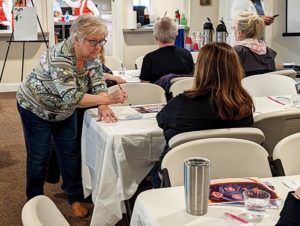
Louise Bath, a Vesterheim Gold Medalist in Rosemaling, teaches workshop participants about the history and basic techniques of Norwegian rosemaling at Historic Trondhjem Church in Lonsdale, Minnesota, in April 2022.
Historic Nordic American churches are deeply embedded in many communities in the Upper Midwest, and their buildings, community engagement, ethnic traditions, and food events are significant civic assets to the larger community. Over the past five years, Partners for Sacred Places has been working with churches in Nordic communities across the region to help them preserve their buildings and sustain their continued presence in their communities.
The commissioning of new folk art builds on an earlier phase of Partners’ Nordic Churches program, which involved working with a cohort of 17 churches to carry out repair and restoration projects with local craftspeople, utilizing matching grant funds that were available as part of the program. The selected churches represented the ethnic and geographic diversity of the region, and the buildings reflected Nordic heritage through their architecture, decorative arts, and maintenance of ethnic traditions.
Another of the current folk art projects is being carried out by Our Savior’s Lutheran Church in Viborg, South Dakota. Our Savior’s is a congregation founded by Danish immigrants in the late nineteenth century, and the building features woodwork and an altar painting by Jes Smidt—a Danish immigrant woodcarver well known in the region for his carved pulpits and altars. Our Savior’s is among the best of Smidt’s intact interiors.
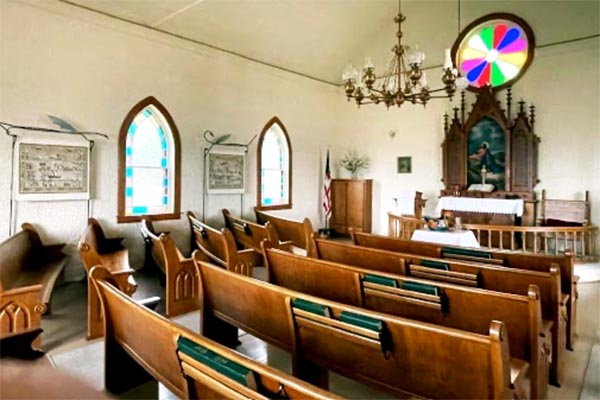
Interior of Hallson Church featuring the commissioned pieces: two floor-mounted decorative iron rods by Dennis Schill, two Swedish bonadsmalning paintings by Pieper Bloomquist, two carved wooden bowls by Rev. Jim Paulson in the style of traditional Nordic ale bowls to be used as a baptismal bowl and dipper, and three Hardanger paraments for the altar, pulpit, and table. Emily Laaveg
Unlike many other Danish churches, however, Our Savior’s did not have a ship model hanging from the ceiling in its center aisle. While this tradition has its roots in Catholic churches in Europe, the Danes—as a seafaring nation—adopted the tradition because ships held special significance. These ships could commemorate loved ones lost at sea, a safe return home, a safe journey across the sea to America, and larger themes, too: navigating the storms of life with God’s help, and the transition from this world to the next.
The team at Our Savior’s wanted to use a grant from the Nordic Churches program to install a ship in its sanctuary. Our Savior’s ship was donated by a former church member’s grandfather—also a former member of Our Savior’s—who worked in the Danish shipyards in Copenhagen prior to coming to America.
While most of the community events planned for the project needed to be delayed due to the COVID-19 pandemic, they are now set to take place across the region in the coming months. When asked to reflect on the importance of the project and its effect on the church and community, Corene Vaughn, project manager for Hallson Icelandic Church, said that “It is a proven fact that the presence of tangible objects and witnessing historic activities create a remembrance of what was taught or experienced during a time in the life of people. Hopefully the four planned events and the tangible pieces of art will help to keep the Nordic folk traditions and customs alive and well. It is human nature to wonder and seek information about who we are and what had happened in the past to make us the people we are today.”
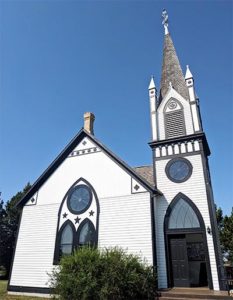
Hallson Church, Icelandic State Park, North Dakota
Emily Sajdak
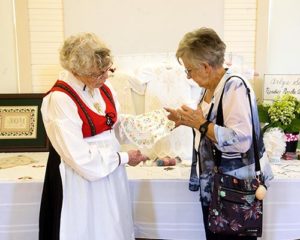
Arlys Sorby, the needleworker who created Hallson Church’s hardanger paraments, talks with a visitor to Hallson’s community event in July 2021. (Barb Gunderson)
Conversation with Pieper Bloomquist, Folk Artist
interviewed by Emily Sajdak
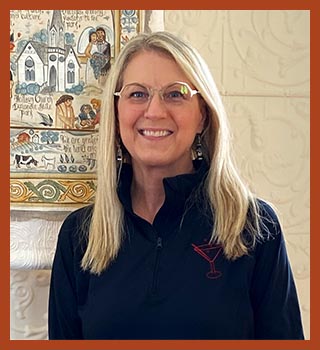
Pieper Bloomquist
Emily Sajdak: What inspired you to participate in the Nordic Churches Project?
Pieper Bloomquist: It is exciting to work with people who are pro-active in their communities and interested in thinking outside of the box when it comes to local activities that can bring neighbors together. As an artist involved in the project, I am pleased that Nordic folk art is valued.
ES: Could you speak to your process for creating pieces? How did that process play out in your work with Hallson Church?
PB: I met with the community members and gathered the stories they wanted to tell about their church. I chose common themes and developed a story board sketch, using actual photos provided by the community, as well as many I found in the local historical museum and in my own research. In the case of the second piece for Hallson Church, I enlisted the help of Hillary Kempenich, Turtle Mountain Anishinaabe Artist, to provide designs and consultation in representing the indigenous imagery and symbolism.
Once the sketch is done, the main features (borders and figures) are transferred to a piece of linen that has been base-coated with a ground. Main features, buildings and figures are outlined and I paint in some of the things I want to have a certain way – such as faces and some images that need to be particular colors. We then host a community paint day, where a group of community members and they are guided to paint in the base colors of the outlined figures. I then take the painting home, finish embellishing the figures, add the floral elements, and script. The artwork is then cut to actual size, edges frayed, and then hand-sewn onto the mounting fabric.
While I try to use all traditional materials, in the case of a community painting- where members of the public (all ages) are going to be contributing to the actual painting – I use acrylic ground since it is more forgiving than a traditional gesso or wheat paste/egg ground when fixing painting errors. I make creamy liquid paint using powdered pigments and a mixture of egg yolk/vinegar/water with a drop of clove oil. This part seems to be the most intriguing thing for many people who want to participate.
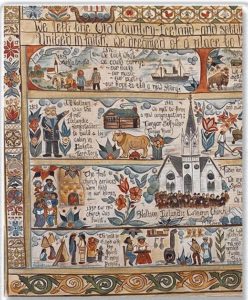
Detail of a Swedish bonadsmalning painting by
Pieper Bloomquist. (Pieper Bloomquist)
Regarding the script: That planning and execution is very fluid and develops over the course of the entire process. Some of the script is given to me in the form of written information or verbal from the discussion, and so there are places designed for certain phrases up front. But much of it is only half-formed in my head. I leave spaces throughout the painting and in the sketch simply write “put some words here”, like caption holders. Usually at the very end after everything is painted is when I need to get poetic and concise. And I am terrified of spelling errors. I have everyone I know go over the words when I am done!
ES: What role did the community event in July 2021 play in your work? What stands out to you about that day?
PB: The visibility of working artists is key to any community project involving art. Non-artists need to see and experience the work being done in order to relate to it and gather meaning from it. I think having all of the artists visible that day – dressed in folk dress and working on their craft – added to the festive atmosphere of the day and educated the community about the importance of what was taking place at their church.
For me, it was really fun to just show folks how easy it is to paint with egg yolk. That is a show stopper, a mystery, and really captures attention. I was also able to bring many of my other paintings to display and I think community members were more impressed with what we were doing once they saw the other artists working, and my sketches and script I planned to include in the paintings.
ES: Do you think that your work has inspired or encouraged others to follow in your footsteps, i.e., learn and practice traditional Swedish/Nordic folk art painting?
PB: Absolutely. I think the visibility of my artwork in the past couple of years has drawn attention to the Swedish folk painting styles. Often it is the story telling and design that is more interesting than the technical skill!
